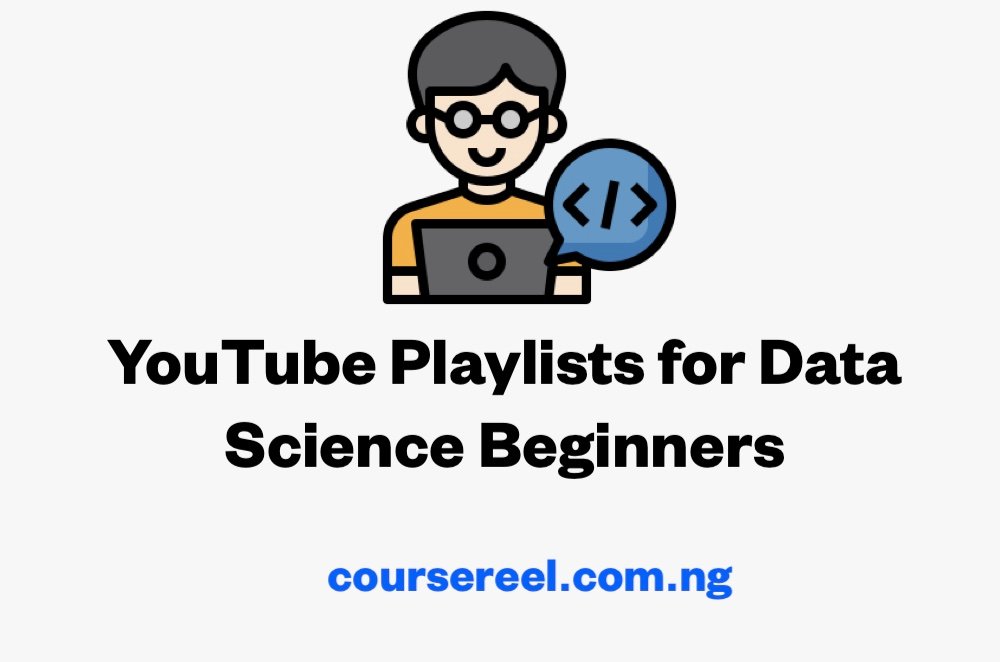Top 10 Free Database Courses in 2024. Advance your data skills with the best free database courses in 2024. Learn SQL and database management from top universities and platforms.
In today’s data-driven world, understanding databases and the ability to query them with SQL (Structured Query Language) has become essential for many careers. Whether you’re a data analyst, web developer, marketer, or want to improve your data handling skills, learning databases is a smart investment.
The great news? You don’t need to break the bank to gain expertise. In this blog post, we’ll explore the top 10 free database courses in 2024, allowing you to master SQL and database concepts without spending a dime.
Read also: Top 5 Free Online Summer Courses for High School Credit.
10 Best Free Database Courses in 2024
Let’s take a closer look at the top 10 free database courses in 2024, designed to help you master SQL and database concepts:
1. SQL for Data Analysis (Mode)
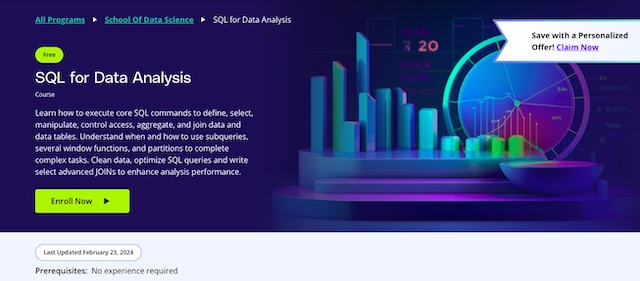
A comprehensive course ideal for aspiring data analysts, covering essential SQL commands and in-browser coding exercises.
This course is divided into 7 sections and spans over 4 weeks. The primary learning resources include lecture videos, course articles, and quizzes. You will have access to an in-built database management system within the browser to practice writing SQL queries.
What this Free Database Courses has to offer:
The course will start by introducing you to SQL basics for working with a single table. You will learn common SQL commands such as SELECT and FROM, which are used to get columns from a table. The WHERE clause will also be covered, which is used to specify a condition that needs to be met. You will also learn how to use logical operators, such as AND and OR, to combine conditions together.
First, you will learn how to use JOIN commands to combine data from multiple tables based on mathematical set operators. You will learn how to use JOIN, INNER JOIN, LEFT JOIN, and RIGHT JOIN.
SQL is a popular tool for data scientists because of its ability to perform basic statistical operations such as SUM, MIN, and MAX. These aggregate functions are useful for extracting insights from the data. Additionally, you can learn other functions such as CASE, HAVING, and DATE to enhance your toolkit.
If a single query does not provide you with the necessary data, you can utilize subqueries. These are nested querying methods that can help you answer complex business questions. You can also use temp tables to access tables with more than one query. Furthermore, you will learn how to clean data in SQL.
The course covers two advanced SQL topics. The first topic is about window functions, which allow you to compare one row to another without the need for any join. The second topic is about advanced joins and performance tuning. This section will be particularly useful in preparing for interviews.
| Institution | Mode |
| Provider | Udacity |
| Instructor | Derek Steer |
| Level | Beginner |
| Workload | 4 weeks long |
| Certificate | None |
2. Databases: Relational Databases and SQL (Stanford University)
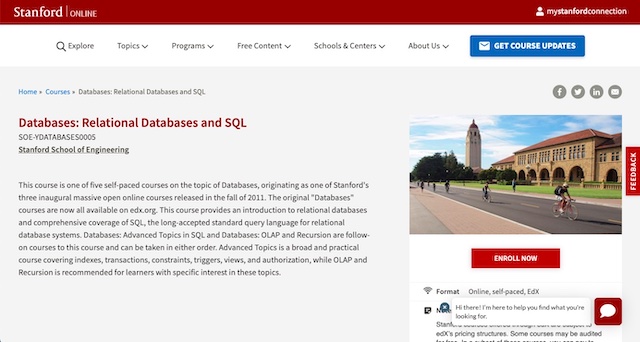
A university-level course offering a deep dive into relational databases and SQL, with a focus on both query writing and database design.
This course is a 2-week program. Each week requires 8-10 hours of commitment, and the curriculum comprises video lectures and exercises that assess your query writing skills.
| Institution | Stanford University |
| Provider | edX |
| Instructor | Jennifer Widom |
| Level | Beginner |
| Workload | 16—20 hours total |
| Enrollments | 58K |
| Certificate | Paid |
3. Introduction to SQL (Davidson College)
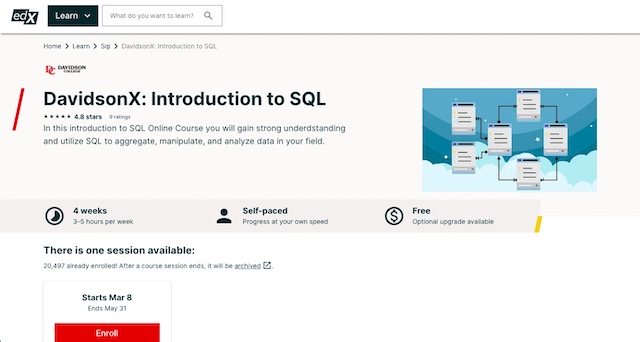
Learn the fundamentals and advanced SQL concepts through the PostgreSQL flavour of SQL. A great choice if you’re new to databases.
This is a 4-week course, with each week requiring 3-5 hours of study through video lectures and course materials.
What this Free Database Courses has to offer:
The course will start by providing a brief history of SQL. You will get to know what a relational database is, the relationship between SQL and relational databases, and the reasons why SQL is a highly useful tool to learn. Additionally, the course will explain why there are multiple versions of SQL.
The course covers the fundamentals of SQL such as query structuring, data selection from tables, setting filters for your queries, using functions to aggregate data, and many other commands related to data within a single table.
In the next section of the course, you will be introduced to the concept of JOINs. You will learn when and how to use them to combine data from multiple tables and also how to inspect and manipulate data within a database. Finally, the course will conclude by teaching you about analytic functions and how to pivot a database.
| Institution | Davidson College |
| Provider | edX |
| Instructor | Pete Benbow |
| Level | Beginner |
| Workload | 12—20 hours total |
| Enrollments | 12K |
| Certificate | Paid |
4. Intro to SQL (Kaggle)
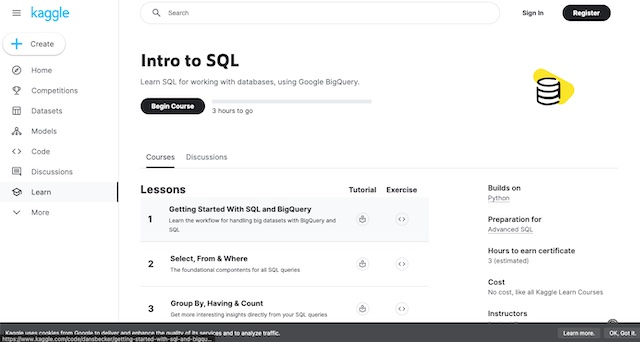
Perfect for those with basic Python knowledge, this course teaches how to use SQL with Google BigQuery, allowing you to work with large datasets.
This course consists of six lessons and has a total duration of three hours. You will learn by going through the provided Jupyter notebooks. After each lesson, you will apply your knowledge by doing hands-on coding in an exercise notebook. This will help you solidify your understanding of the material. Upon completing each exercise, you will be rewarded with a free certificate.
What this Free Database Courses has to offer:
At the start of the course, you will be introduced to SQL and BigQuery. SQL is a programming language used for managing databases, whereas BigQuery is a web service provided by Google that enables you to work with large datasets using SQL. You will learn the fundamentals of accessing and analyzing BigQuery datasets.
In this lesson, you will be introduced to the fundamental structure of an SQL query. You will begin by retrieving data from tables using the SELECT and FROM commands and then refining the data using WHERE conditions. As you progress through the lesson, you will learn additional commands such as GROUP BY for combining columns and ORDER BY for sorting data. By following these steps, you will gradually build your SQL query skills.
SQL offers functions that enable you to summarize and obtain statistical insights into your data, including COUNT and SUM. Additionally, you will learn how to tidy up data obtained from your query by using the AS keyword to rename returned columns, and how to write nested queries using the WITH keyword for ease of use.
The final section of this course teaches how to merge data from multiple tables using JOIN. It is a valuable skill for solving real-world problems.
| Institution | Kaggle |
| Instructor | Rachael Tatman and Alexis Cook |
| Level | Beginner |
| Workload | 3 hours total |
| Certificate | Free |
5. Introduction to SQL (SQLBolt)
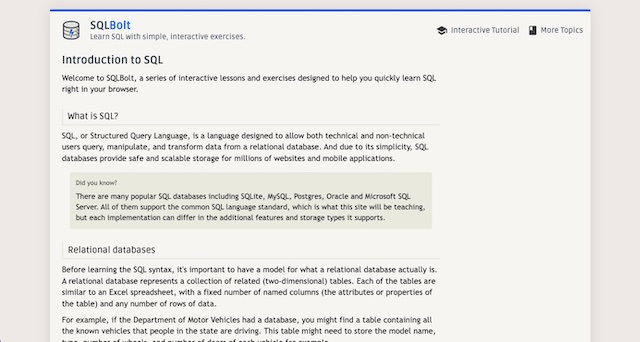
Get started with SQL quickly through interactive lessons and exercises. Covers query writing and basic database creation.
This course comprises 18 core lessons and takes approximately 2-3 hours to complete. You will primarily learn by reading articles and completing SQL coding exercises embedded in the browser.
What this Free Database Courses has to offer:
The course begins by teaching you how to write an SQL query in a simple and easy-to-understand manner. You’ll be introduced to fundamental operations like SELECT and DELETE, as well as learning how to apply conditionals like WHERE to filter and constrain your queries. Additionally, you’ll gain an understanding of SQL functions such as COUNT() and AVG(), which will assist you in analyzing your data more effectively.
The course will guide you on how to use JOIN, an important concept to master the SQL language. JOINs are used to combine query results from multiple tables into a single table. You will be taught about different types of JOINs, such as INNER JOIN and OUTER JOIN.
Towards the end of the course, you will be taught how to directly modify a table. You will learn how to insert, update, and delete rows from a pre-existing table, as well as how to create a new table, modify the properties of an existing table, and delete tables.
| Institution | SQLBolt |
| Level | Beginner |
| Workload | 2—3 hours total |
| Certificate | None |
6. Foundations for Big Data Analysis with SQL (Cloudera)
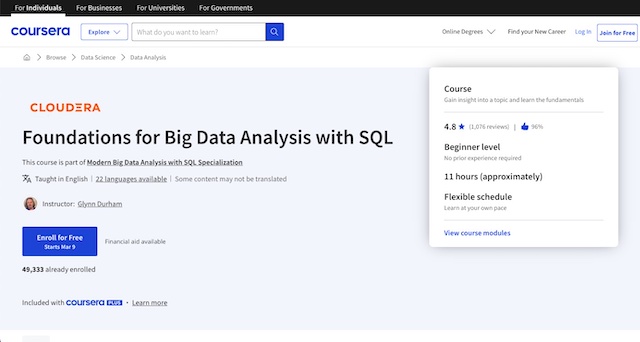
Delve into the world of big data and learn how SQL can be adapted to handle massive datasets.
This is a 5-week course that includes 12 hours of material. The lecture videos, course readings, and discussion prompts will be the primary mode of learning.
What this Free Database Courses has to offer:
The course starts by defining data and databases. You will explore the various applications of database systems, particularly relational databases.
After covering the basics, you’ll learn SQL concepts and vocabulary used by all users of relational databases. Starting with the fundamentals of database design, you’ll learn about primary keys, foreign keys, and database triggers.
The course covers big data characteristics including the “three V’s”: volume, velocity, and variety. The differences between big data and relational databases are also explained.
It’s important to note that big data and SQL do not always work well together. Relational databases are not designed to handle big data. However, some technologies can adapt SQL to big data. These systems handle metadata differently from traditional relational systems, and it’s important to understand how they work. Additionally, when storing Big Data, you have the option to use your own company data centres or cloud storage. It’s crucial to consider the advantages and disadvantages of each option before making a decision.
The course concludes with hands-on practice of two widely used technologies, Apache Hive and Apache Impala, where you will interact with and explore data, and write a report on your findings.
| Institution | Cloudera |
| Provider | Coursera |
| Instructor | Glynn Durham |
| Level | Beginner |
| Workload | 12 hours total |
| Enrollments | 43K |
| Rating | 4.8 / 5.0 (1K) |
| Certificate | Paid |
7. Introduction to SQL (DataCamp)
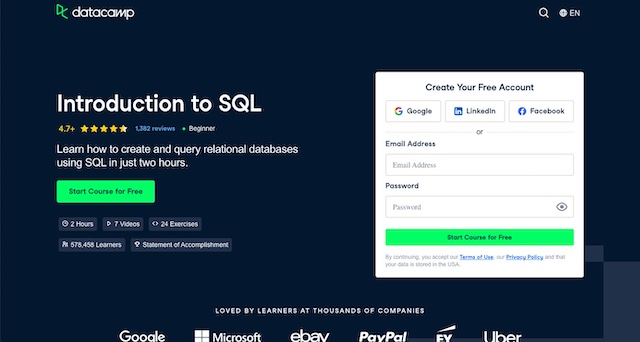
Master general SQL syntax used across various database systems like PostgreSQL and MySQL. Includes a free certificate.
This course comprises four sections and takes a total of four hours. You’ll learn through reading articles, interactive coding exercises, and multiple-choice quizzes.
What this Free Database Courses has to offer:
The course starts with a concise introduction to relational databases. Initially, you will gain knowledge about the organization and structure of a database. After that, you will learn how to use the SELECT statement to choose one or more columns, and also get familiar with some essential functions.
In this section, you will learn how to filter data using basic comparison operators like AND, OR, and BETWEEN. Additionally, you will learn how to filter for text and words using the WHERE statement, which will help you extract valuable information.
In the third section, the course covers aggregate functions that summarize data into simple statistics. Aliases are used to name query results and improve readability.
In the final section of this course, you will learn how to sort data using ORDER BY and group results using GROUP BY. Although GROUP BY may seem difficult to understand at first, you will soon appreciate its usefulness when working with multiple conditions at the same time. The course will conclude with a final exercise that will allow you to apply all the concepts you have learned throughout the course.
| Institution | DataCamp |
| Instructor | Nick Carchedi |
| Level | Beginner |
| Workload | 4 hours total |
| Enrollments | 1.4M |
| Certificate | Free |
8. The Structured Query Language (SQL) (University of Colorado Boulder)
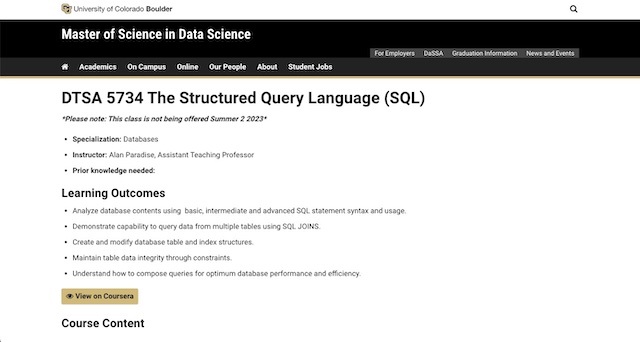
A rigorous, lab-based course covering a wide range of SQL commands and database design principles.
This is a 6-week course consisting of 25 hours of material. The primary learning will be through lecture videos and assigned readings.
What this Free Database Courses has to offer:
The course begins with a discussion of the history and origins of SQL, followed by an in-depth look at its most used statement – SELECT. When programming in SQL, a significant portion of your work will involve SELECT statements. As a result, a significant portion of this course will be devoted to teaching you about the SELECT statement and its various uses.
In this lesson, you will learn about group functions and their use in generating subtotals. Additionally, you will be introduced to subqueries, which involve embedding one query inside another query to return results used by the outer query. Furthermore, you will explore the SQL Join and its powerful capabilities for retrieving data from multiple tables by performing mathematical set operations.
In your SQL course, you will learn about two important concepts – Data Definition Language (DDL) and Data Manipulation Language (DML). DDL is used for creating and modifying tables, while DML is used for updating, inserting, and deleting records from those tables. You will also be introduced to some advanced SQL concepts such as VIEW, CASE, and UNION, which you can practice with.
| Institution | University of Colorado Boulder |
| Provider | Coursera |
| Instructor | Alan Paradise |
| Level | Beginner |
| Workload | 25 hours total |
| Enrollments | 8K |
| Rating | 4.8 / 5.0 (72) |
| Certificate | Paid |
9. SQL for Data Science (University of California, Davis)
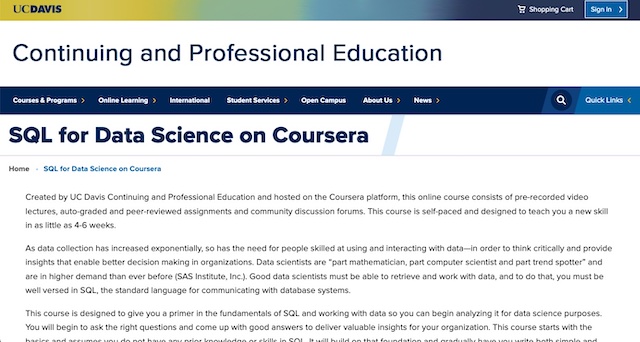
Designed for data science enthusiasts, this course helps you use SQL to shape and analyze data effectively.
This course is designed to help you learn new skills through a four-week program that contains 14 hours of valuable material. The course is structured around watching lecture videos, reading course materials, and testing your knowledge with practice quizzes.
If you decide to pay for the certification, you will have access to two types of graded weekly quizzes – a theoretical quiz and a coding quiz. These quizzes are designed to help you reinforce your learning and prepare you for the graded peer review that you will receive at the end of the course.
The goal is to provide a positive and engaging learning experience that will help you acquire new knowledge and skills with confidence.
| Institution | University of California, Davis |
| Provider | Coursera |
| Instructor | Sadie St. Lawrence |
| Level | Beginner |
| Workload | 14 hours total |
| Enrollments | 413K |
| Rating | 4.6 / 5.0 (13K) |
| Certificate | Paid |
10. Introduction to Structured Query Language (SQL) (University of Michigan)
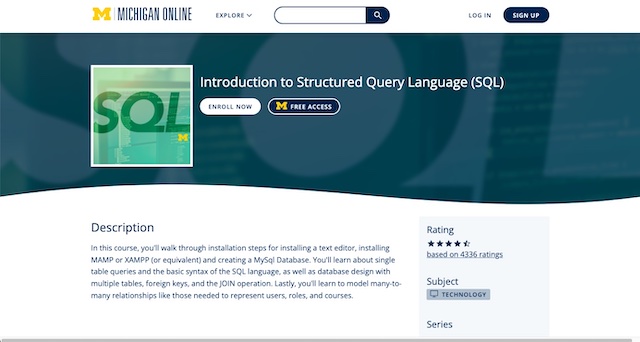
Focuses on MySQL. Learn to install development environments and master the core syntax of the MySQL language.
This 4-week course includes 16 hours of material. You’ll learn primarily from video lectures, course articles, and practice quizzes.
| Institution | University of Michigan |
| Provider | Coursera |
| Instructor | Charles Severance |
| Level | Intermediate |
| Workload | 16 hours total |
| Enrollments | 144K |
| Rating | 4.8 / 5.0 (4.5K) |
| Certificate | Paid |
Read also: NOUN Transcript & Document Verification Guide.
Conclusion: Free Database Courses.
Learning about databases and SQL is a valuable investment in your professional and personal development. With the abundance of free, high-quality database courses in 2024, there’s no excuse not to dive in and start mastering these in-demand skills.
Choose a course that aligns with your learning style and goals, and get ready to unlock the power of data!
Are you ready to start your database learning journey? Let us know in the comments which of these free database courses piques your interest!

